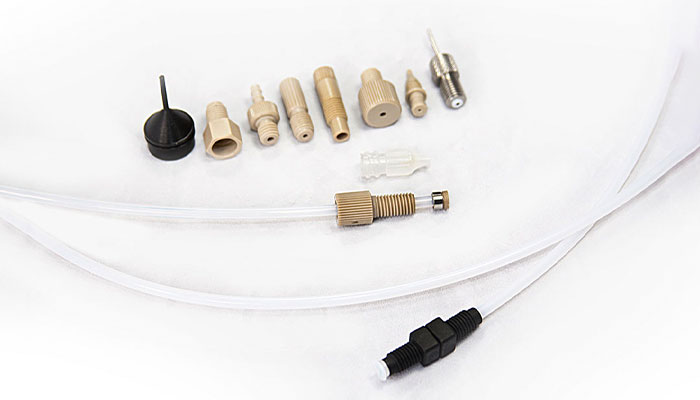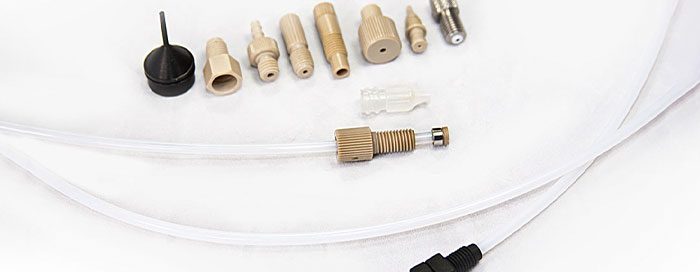In the OEM marketplace, custom-designed tubing and fitting assemblies are critical for a variety of applications and industries. So, let’s take a closer look at what tubing fittings are, the different types of fittings, common applications for each, and tipping methods performed on these tubing assemblies.
What Is a Tubing Fitting?
A tubing fitting is a part used to attach or adapt tubing to provide leak-free connection in a fluid system between components such as pumps, reservoirs, containers, and sample chambers.
Tubing fittings are designed as either a single part or two parts, where the two parts are comprised of a nut and a ferrule. The nut is the threaded portion tightened into port, and the ferrule is a tapered ring used to create a compressive seal between the port and tubing.

It is important to note that there are a variety of fittings with differences in material, inner diameter, and head geometry.
Material
- Polymer-Based: PEEK, Acetal, PCTFE, Polypropylene
- Metal: 300-Series Stainless Steel
- For higher pressure application, we typically see PEEK, PCTFE, and Stainless Steel
- Differences in chemical compatibility, operating pressure and temperature, as well as cost
Inner Diameter
- Inner diameter for tubing: Ø3mm, Ø2mm, Ø1mm, Ø.125”, Ø.062”, and more
Head geometry
- Knurled (hand tightened), typically for lower pressure applications
- Hex and Wrench Flat, typically for higher pressure applications
- Thread Sizes: 1/4-28, 10-32, 6-40, M6x1, and more
Flanged Fittings
Flanged fittings are fittings where the end of the tubing requires flanging before use. The flanged section is pressed into a threaded port which seals against the face in the bottom of the port.
Applications Best Suited for Flanged Fittings:
Flanged fittings are best suited to most applications. They are the least expensive option—and they are the best option if the user intends to disconnect the tubing and reconnect it for use. Flanged fittings can only be used for fluoropolymer tubing such as FEP or PTFE.
Flangeless Fittings
Flangeless fittings use a two-part fitting composed of a nut and ferrule, used in flat bottom or coned ports. The ferrule is tapered toward the nut with the flat end flush against the port in flat-bottomed ports. The internally tapered cavity of the nut creates an interference with the ferrule when the fitting is tightened into the port. This compression holds the tube in place while creating the leak-tight connection. In coned ports, the ferrule tapered nose is toward the port.
Applications Best Suited for Flangeless Fittings:
Flangeless fittings are the best option for more rigid tubing, such as PEEK. They are also a good option when the tubing required is very short, as there is a lower limit to the length of tubing that can be flanged.
Coned Fittings
Coned fittings use a cone shape to squeeze the fitting onto the tubing, similar to the ferule on the flangeless fittings. However, with coned fittings, the ferrule’s tapered nose is toward the port.
Applications Best Suited for Coned Fittings:
The application that a coned fitting would be better suited for than a flanged fitting is when the application
requires a more rigid tubing such as PEEK. However, the ports for coned fittings are more difficult to machine
than the flat-bottom ports used for flanged and most flangeless fittings. Coned fittings are more typical in high-pressure applications.
Flat-Bottom Fittings
Flat-bottom fittings are fittings where its sealing surface is flat against receiving port. Flat-bottom fittings can be flanged or flangeless—and the ferrules used in these fittings have tapered nose toward the nut. These fittings are intended for use with flat-bottom ports like those we use in most of our valves.
Applications Best Suited for Flat-Bottom Fittings:
Flat bottom fittings are the best option for most use cases. They are effective, inexpensive, and simple to produce and use.
Tipping Methods: Forming the Tip of a Tube
The primary tipping method we use is thermo-forming, which essentially molds the end of a tube into a perfect flange quickly, easily, and reliably. We also have the means of mechanical forming that is more labor intensive and less repeatable. Still have questions about tubing fittings and tipping methods? Get in touch with us today!
Ready to get started? Find the best fittings to meet your system requirements

Leave a comment!